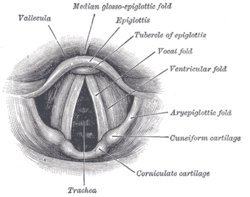Voice pedagogy
| The anatomy of the Vocal folds | |
|---|---|

Laryngoscopic view of the vocal folds.
|
|

|
|
| Details | |
| Precursor | Sixth pharyngeal arch |
| Nerve | N. laryngeus recurrens and N. laryngeus superior |
| Identifiers | |
| Latin | plica vocalis |
| MeSH | A04.329.364.737 |
| Dorlands /Elsevier |
12649423 |
|
Anatomical terminology
[]
|
|
Vocal pedagogy is the study of the art and science of voice instruction. It is used in the teaching of singing and assists in defining what singing is, how singing works, and how proper singing technique is accomplished.
Vocal pedagogy covers a broad range of aspects of singing, ranging from the physiological process of vocal production to the artistic aspects of interpretation of songs from different genres or historical eras. Typical areas of study include:
All of these different concepts are a part of developing proper vocal technique. Not all vocal teachers have the same opinions within every topic of study which causes variations in pedagogical approaches and vocal technique.
Within Western culture, the study of vocal pedagogy began in Ancient Greece. Scholars such as Alypius and Pythagoras studied and made observations on the art of singing. It is unclear, however, whether the Greeks ever developed a systematic approach to teaching singing as little writing on the subject survives today.
The first surviving record of a systematized approach to teaching singing was developed in the medieval monasteries of the Roman Catholic Church sometime near the beginning of the 13th century. As with other fields of study, the monasteries were the center of musical intellectual life during the medieval period and many men within the monasteries devoted their time to the study of music and the art of singing. Highly influential in the development of a vocal pedagogical system were monks Johannes de Garlandia and Jerome of Moravia who were the first to develop a concept of vocal registers. These men identified three registers: chest voice, throat voice, and head voice (pectoris, guttoris, and capitis). Their concept of head voice, however, is much more similar to the modern pedagogists understanding of the falsetto register. Other concepts discussed in the monastic system included vocal resonance, voice classification, breath support, diction, and tone quality to name a few. The ideas developed within the monastic system highly influenced the development of vocal pedagogy over the next several centuries including the Bel Canto style of singing.
...
Wikipedia
